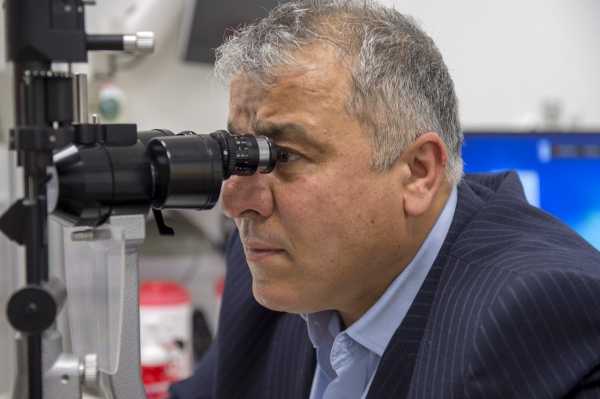
How to Diagnose Eye Problems at the Initial Stage
Most of us experience some eye problems or the other at any time in our lives. While some will be minor that go away by themselves or can be treated easily at home, others necessitate seeing a specialist.
It is always essential to check with your doctor if the symptoms are bad or do not clear up on their own, in a few days. The eyes are one of the most precious organs of our body and vision is the most crucial sense gifted by nature to humankind.
Taking good care of our eyes is vital. Diagnosis of the common eye problems in the initial stage proves crucial for the proper upkeep of our eyes and for ensuring vision.
The Role of Eye Exam in Detecting Eye problems
The best way to detect any eye problem at its earliest stage is through an eye exam. An eye exam is a comprehensive examination involving a series of tests that help evaluate the vision while checking for any eye disease. Eye doctors make use of a variety of instruments for this. An eye doctor may shine a bright light directly at the patient’s eyes, requesting them to look through a range of lenses. This is done to check the vision.
Each test is meant for evaluating a different aspect of the patient’s eye health or vision. Regular eye exam enables your eye care doctor to help you correct the vision changes or adapt to them while providing you the appropriate tips about your eye care.
Tests help to diagnose eye problems early – when they can be treated easily. Eye exam, when performed regularly, is the first line of defense against eye diseases. When performed at the prescribed intervals, it helps prevent vision loss as well.
Why is Diagnosing Eye Problems Early Crucial?
As early detection of problems enables your eye doctor to manage your eye condition effectively, you must get a baseline eye test at regular intervals. Diagnosing eye diseases and the onset of vision loss facilitates appropriate treatment and renders it effective as well.
People who are over the age of 40 need to go for regular eye checks. Especially those who are at high risk of any eye problem must visit the eye specialist every year. Early diagnosis of eye conditions and possible diseases related to the eyes will greatly help in securing your vision.
How to Diagnose the Most Common Eye Diseases in the Early Stage?
It is by recognizing the signals sent out by nature and waking up to these signals that anyone can fend off the threats of any eye disease. As we age, we naturally tend to develop several eye conditions, some minor, and a few, major. You can recognize the tell-tale signs and symptoms of any of these, and when these appear to persist or worsen up, it is vital to consult your eye doctor. Approaching the seasoned eye doctor to get your eyes examined properly will ensure preventing unwanted ramifications. The following are the common eye diseases and their symptoms that you are supposed to be aware of for protecting your eyes and vision:
1. Cataracts
One of the most widely prevalent eye diseases that is faced by myriad people as they age is a cataract, the formation of cloudy spots or areas in the lens of the eye. Its common cataract symptoms are blurred vision, faded view of colors, difficulty seeing at night, and seeing halos around lights.
Diagnosis: Medical history and symptoms facilitate detecting cataracts at the early stages. Your eye doctor will conduct tests such as visual acuity test for diagnosing this eye condition.
2. Macular degeneration
Referred to as AMD, age-related macular degeneration is a very common eye condition that affects millions across the world. The retina’s central portion known as the macula is damaged with aging, leading to this condition.
Diagnosis: Common symptoms of macular degeneration are blurriness of central vision, difficulty seeing in dim light, partial vision loss (formation of blind spots), and objects tending to appear smaller than they really are when viewed with one eye.
A simple test, known as the Amsler grid, helps people to check their vision in relation to this condition. Your eye doctor will conduct tests such as Fundoscopy or Ophthalmoscopy, Optical Coherence Tomography (OCT), tonometry, and Fluorescein Angiography.
3. Diabetic Retinopathy
A complication arising out of diabetes, diabetic retinopathy causes damage to the blood vessels that are spread out throughout the retina’s sensitive tissue. This affects vision.
Diagnosis: The primary diagnosis process is a comprehensive dilated eye test. Fluorescein angiography and Optical coherence tomography are some of the sophisticated examinations that help to detect diabetic retinopathy.
4. Glaucoma
The eye condition in which the eye’s optic nerve gets damaged and gets worse over time is known as glaucoma.
Diagnosis: Tonometry helps to measure the pressure within the eye. Your eye doctor may use a device called the tonometer for conducting this exam.
5. Conjunctivitis
Commonly known as pink eye, conjunctivitis is a condition that inflames the tissues that line the back of the eyelids and cover the sclera. A very commonly prevailing eye problem, conjunctivitis causes your eyes to turn red, blurry, itchy, and teary, leading to sticky discharges.
Diagnosis: An ophthalmologist (eye doctor) will be able to diagnose conjunctivitis and whether it is due to allergens, bacteria, or virus, mostly based on the patient’s history and symptoms, in addition to an eye exam.
6. Dry Eyes Syndrome
The eyes are kept lubricated by tears. The failure of tears to provide sufficient lubrication will lead to a condition called dry eye syndrome.
Diagnosis: the Schirmer test is usually used by eye doctors to measure the tear production of your eyes. The surface condition of your eyes can be determined using certain special dyes.
7. Uveitis
The uvea is the middle layer of the eye that contains several blood vessels. Uveitis, the collective term, refers to a group of eye conditions that cause inflammation of the uvea. This disease may even lead to loss of vision in certain cases.
Diagnosis: A thorough examination by the ophthalmologist is required for diagnosing uveitis. Common tests include x-rays, blood tests, and eye scans.
8. Retinal Detachment
The detachment or separation of the retina from its underlying tissues that hold it in place inside the eye is called retinal detachment. Small areas of the retinal may get torn, eventually resulting in this condition.
Diagnosis: A retinal examination using an instrument that has special lenses and bright light helps study the back of the eye.
9. Night Blindness
Known as Nyctalopia, the type of vision impairment that causes an inability to see properly in dim light or at night is a common eye condition.
Diagnosis: Blood test helps to measure glucose and vitamin levels that are instrumental in causing this condition.
10. Eyestrain
One of the most common eye problems, eyestrain is the condition in which the eyes get fatigued and tiresome because of intense use. Driving long distances, looking at a computer screen for a prolonged period are some instances after which this condition commonly occurs.
Diagnosis: Physicians make a diagnosis of eyestrain or computer vision syndrome based on patient history and the absence of any other eye diseases.
11. Color Blindness
The condition in which the pigments in the eye cones have issues and cause you not to see colors normally is known as color blindness or color deficiency. Red-green color blindness is the most common form of this problem.
Diagnosis: There are simple screening tests to diagnose color blindness in early childhood. The Ishihara color plate test and the Hardy-Rand-Rittler plates are used for evaluating the degree and type of color deficiency.
12. Eye Floaters
Eye floaters are spots in the vision. They appear in the form of grey or black specks, strings, or cobwebs around the eye’s movement. These tend to dart away when you try to look through them. These issues are age-related.
Diagnosis: Your eye doctor may conduct a complete eye exam that includes eye dilation. This enables looking at the back of the eyes and determining the cause of the eye floaters.
13. Nearsightedness
The eye condition in which you can view objects that are close to you clearly but you get a blurry vision when looking at objects far away is called myopia or nearsightedness.
Diagnosis: Basic eye exam including an eye health exam and refraction assessment helps to diagnose nearsightedness.
14. Farsightedness
Opposite of nearsightedness, in this condition, known as farsightedness or hypermetropia, you have a clear vision of things far away while getting blurs when looking at those nearby.
Diagnosis: Clinical signs and symptoms help diagnose farsightedness. Your ophthalmologist will check your vision using an eye chart, at different distances. A magnifying lens may be used to look more closely at the eyes.
Wrap-up
Our eyes are the most sensitive and highly complex parts of our body that require regular care and continuous preservation. Taking good care of our eyes is crucial for leading a healthy and vibrant life. Consulting your eye doctor if you have any problematic symptoms or signs is imperative in this regard.
About Lotus Eye Hospital
Lotus Eye Hospital, one of the top eye hospitals in India, has seven branches to its name in Tamil Nadu as well as Kerala. The aim is to offer excellence in providing eye treatments, by solving a large number of eye problems and ailments, using the latest tools and technologies. We aim to diagnose the problems at an early stage and try to sort out the issue to offer clear vision for everyone.


